Diversity of Ladybird Beetles (Coleoptera: Coccinellidae) in Tenerife and La Gomera (Canary Islands): The Role of Size and Other Island Characteristics
Abstract
Simple Summary
Abstract
1. Introduction
2. Study Area, Materials and Methods
3. Results
- Microweiseinae Leng, 1920
- Serangiini Pope, 1962
- Coccinellinae Latreille, 1807
- Stethorini Dobzhansky, 1924
- Coccinellini Latreille, 1807
- Noviini Mulsant, 1846
- Scymnini Mulsant, 1846
- Hyperaspidini Mulsant, 1846
- Diomini Gordon, 1999
- Azyini Mulsant, 1850
- Chilocorini Mulsant, 1846
- Sticholotidini Pope, 1962
- Coccidulini Mulsant, 1846
- Tetrabrachyni Kapur, 1948
4. Discussion
| Tenerife | La Gomera | |||
|---|---|---|---|---|
| Species | This Study | Literature Data | This Study | Literature Data |
| Delphastus catalinae (Horn) | + | [10] | + | [10] |
| Stethorus tenerifensis Fürsch | + | [9] | + | [2] |
| Stethorus wollastoni Kapur | + | [3] | + | [3] |
| Adalia bipunctata (L.) | [38] | [10] | ||
| Adalia decempunctata (L.) | + | [10] | ||
| Adalia testudinea (Wollaston) | [37] | |||
| Cheilomenes propinqua (Mulsant) | + | [10] | ||
| Coccinella miranda Wollaston | + | [3] | + | [3] |
| Coccinella septempunctata algerica Kovář | + | [3] | + | [3] |
| Harmonia axyridis (Pallas) | + | [10] | ||
| Hippodamia variegata (Goeze) | + | [7] | + | [2] |
| Myrrha octodecimguttata (L.) | + | [39] | ||
| Oenopia doublieri (Mulsant) | [40] | + | ||
| Olla v-nigrum (Mulsant) | + | [41] | + | |
| Vibidia duodecimguttata (Poda) | [2] | |||
| Novius cardinalis (Mulsant) | + | [7] | + | [38] |
| Novius cruentatus (Mulsant) | + | [38] | ||
| Novius canariensis Korschefsky | [38] | |||
| Clitostethus arcuatus (Rossi) | + | [3] | [38] | |
| Nephaspis bicolor Gordon | + | [25] | ||
| Nephus (Bipunctatus) conjunctus (Wollaston) | [9] | |||
| Nephus (Geminosipho) reunioni (Fürsch) | + | |||
| Nephus (Nephus) binotatus (Brisout) | [10] | |||
| Nephus (Nephus) flavopictus (Wollaston) | + | [3] | + | [4] |
| Nephus (Nephus) incisus (Har. Lindberg) | + | [8] | + | [39] |
| Nephus (Sidis) depressiusculus (Wollaston) | [2] | |||
| Scymnus (Mimopullus) cercyonides Wollaston | + | [3] | + | [3] |
| Scymnus (Mimopullus) marinus (Mulsant) | + | [9] | [9] | |
| Scymnus (Pullus) canariensis Wollaston | + | [3] | + | [3] |
| Scymnus (Pullus) medanensis Eizaguirre | + | [10] | ||
| Scymnus (Pullus) subvillosus (Goeze) | [9] | [9] | ||
| Scymnus (Scymnus) interruptus (Goeze) | [9] | |||
| Scymnus (Scymnus) nubilus Mulsant | + | [9] | + | [9] |
| Scymnus (Scymnus) rubromaculatus (Goeze) | [39] | |||
| Scymnus (Scymnus) rufipennis Wollaston | [3] | [3] | ||
| Hyperaspis vinciguerrae Capra | + | |||
| Diomus gillerforsi Fürsch | + | [9] | ||
| Diomus rubidus Motschulsky | + | [42] | ||
| Cryptolaemus montrouzieri Mulsant | + | [38] | + | [43] |
| Chilocorus canariensis Crotch | + | [3] | + | [3] |
| Parexochomus nigripennis (Erichson) | + | [38] | + | [38] |
| Coelopterus sp. | + | |||
| Pharoscymnus decemplagiatus (Wollaston) | + | [3] | + | [4] |
| Pharoscymnus flexibilis Mulsant | + | |||
| Rhyzobius litura (Fabricius) | + | [3] | + | [4] |
| Rhyzobius lophanthae (Blaisdell) | + | [44] | + | [10] |
| Tetrabrachys deserticola (Wollaston) | + | [38] | ||
| No. species | 35 | 42 | 20 | 24 |
| Total no. species | 47 | 26 | ||
| First Record in the Canary Islands | Current Distribution | |||||||||
|---|---|---|---|---|---|---|---|---|---|---|
| Species | Year | Island | Reference | L | F | GC | T | G | P | H |
| Delphastus catalinae (Horn) | before 2002 | T, G | [48] | + | + | + | + | + | + | |
| Harmonia axyridis (Pallas) | 2003 | T | [10] | + | ||||||
| Olla v-nigrum (Mulsant) | 2011 | T | this study | + | + | + | + | + | ||
| Novius cardinalis (Mulsant) | 1931 | T | [7] | + | + | + | + | + | + | + |
| Nephaspis bicolor Gordon | 2015 | T | [25] | + | + | |||||
| Nephus reunioni (Fürsch) | 2019 | T | this study | + | + | |||||
| Cryptolaemus montrouzieri Mulsant | 1966 | T | [38] | + | + | + | + | + | + | + |
| Pharoscymnus flexibilis Mulsant | 2016 | F | [47] | + | + | + | ||||
| Rhyzobius lophanthae (Blaisdell) | 1964 | T | [44] | + | + | + | + | + | + | + |
| Hyperaspis vinciguerrae Capra | 1925–1927 | GC | [5] | + | + | + | + | |||
Supplementary Materials
Author Contributions
Funding
Data Availability Statement
Acknowledgments
Conflicts of Interest
References
- Florencio, M.; Patiño, J.; Nogué, S.; Traveset, A.; Borges, P.A.V.; Schaefer, H.; Amorim, I.R.; Arnedo, M.; Ávila, S.P.; Cardoso, P.; et al. Macaronesia as a Fruitful Arena for Ecology, Evolution, and Conservation Biology. Front. Ecol. Evol. 2021, 9, 718169. [Google Scholar] [CrossRef]
- Oromí, P.; de la Cruz, S.; Báez, M. Lista de Especies Silvestres de Canarias. Hongos, Plantas y Animales Terrestres; Arechavaleta, M., Rodríguez, S., Zurita, N., García, A., Eds.; Gobierno de Canarias: Tenerife, Spain, 2010; pp. 254–301. (In Spanish) [Google Scholar]
- Wollaston, T.V. Catalogue of the Coleopterous Insects of the Canaries in the Collection of the British Museum; Order of the Trustees: London, UK, 1864; xiii + 648p. [Google Scholar]
- Wollaston, T.V. Coleoptera Atlantidum Being an Enumeration of the Coleopterous Insects of the Madeiras, Salvages, and Canaries; John van Voorst: London, UK, 1865; xlvii + 526p. [Google Scholar]
- Uyttenboogaart, D.L. Contributions to the knowledge of the fauna of the Canary-Islands. Synopsis of the results of the collecting-excursions 1925 and 1927. Tijdschr. Entomol. 1930, 73, 211–235. [Google Scholar]
- Uyttenboogaart, D.L. Contributions to the knowledge of the fauna of the Canary Islands. XVII. Remarks concerning collections of Canarian Coleoptera in the Zoological Museum at Hamburg and in the Museo Pietro Rossi at Duino. Tijdschr. Ent. 1934, 77, 162–166. [Google Scholar]
- Uyttenboogaart, D.L. Report on Canarian Coleoptera collected by R. Frey and R. Storå in 1931 for the Museum Zoologicum Universitatis Helsingfors. Comment. Biol. 1935, 6, 5–17. [Google Scholar]
- Lindberg, H. Beitrag zur Kenntnis der Käferfauna der Kanarischen Inseln. Comment. Biol. 1950, 10, 1–20. [Google Scholar]
- Fürsch, H. Die Scymninae der Kanaren, Azoren und Madeiras (Coleoptera Coccinellidae). Acta Coleopt. 1987, 3, 1–14. [Google Scholar]
- Eizaguirre, S. Revisión de los coleópteros coccinélidos de las islas Canarias (Coleoptera: Coccinelidae). Bol. Soc. Entomol. Aragon. 2007, 41, 101–118. [Google Scholar]
- Romanowski, J.; Ceryngier, P.; Vĕtrovec, J.; Szawaryn, K. The Coccinellidae (Coleoptera) from Fuerteventura, Canary Islands. Zootaxa 2019, 4646, 101–123. [Google Scholar] [CrossRef] [PubMed]
- Romanowski, J.; Ceryngier, P.; Szawaryn, K. New data on the Coccinellidae (Coleoptera) from Lanzarote, Canary Islands. Coleopts Bull. 2020, 74, 188–194. [Google Scholar] [CrossRef]
- Romanowski, J.; Ceryngier, P.; Vĕtrovec, J.; Piotrowska, M.; Szawaryn, K. Endemics versus newcomers: The ladybird beetle (Coleoptera: Coccinellidae) fauna of Gran Canaria. Insects 2020, 11, 641. [Google Scholar] [CrossRef]
- Romanowski, J.; Ceryngier, P.; Zmuda, C.; Vĕtrovec, J.; Szawaryn, K. The Coccinellidae (Coleoptera) from El Hierro, Canary Islands. Bonn Zool. Bull. 2020, 69, 249–261. [Google Scholar] [CrossRef]
- Romanowski, J.; Ceryngier, P.; Vĕtrovec, J.; Szawaryn, K. The ladybird beetles (Coleoptera: Coccinellidae) of La Palma. Insects 2023, 14, 655. [Google Scholar] [CrossRef] [PubMed]
- Fernández-Palacios, J.M.; Whittaker, R.J. The Canaries: An important biogeographical meeting place. J. Biogeogr. 2008, 35, 379–387. [Google Scholar] [CrossRef]
- MacArthur, R.H.; Wilson, E.O. The Theory of Island Biogeography; Princeton University Press: Princeton, NJ, USA, 1997. [Google Scholar]
- Juan, C.; Emerson, B.C.; Oromí, P.; Hewitt, G.M. Colonization and diversification: Towards a phylogeographic synthesis for the Canary Islands. Trends Ecol. Evol. 2000, 15, 104–109. [Google Scholar] [CrossRef] [PubMed]
- Che, L.; Zhang, P.; Deng, S.; Escalona, H.E.; Wang, X.; Li, Y.; Pang, H.; Vandenberg, N.; Ślipiński, A.; Tomaszewska, W.; et al. New insights into the phylogeny and evolution of lady beetles (Coleoptera: Coccinellidae) by extensive sampling of genes and species. Mol. Phylogenet. Evol. 2021, 156, e107045. [Google Scholar] [CrossRef] [PubMed]
- Hoelmer, K.A.; Pickett, C.H. Geographic origin and taxonomic history of Delphastus spp. (Coleoptera: Coccinellidae) in commercial culture. Biocontrol Sci. Technol. 2003, 13, 529–535. [Google Scholar] [CrossRef]
- Roy, H.E.; Brown, P.M.J.; Adriaens, T.; Berkvens, N.; Borges, I.; Clusella-Trullas, S.; Comont, R.F.; De Clercq, P.; Eschen, R.; Estoup, A.; et al. The harlequin ladybird, Harmonia axyridis: Global perspectives on invasion history and ecology. Biol. Invasions 2016, 18, 997–1044. [Google Scholar] [CrossRef]
- Vandenberg, N.J. Revision of the New World lady beetles of the genus Olla and description of a new allied genus (Coleoptera: Coccinellidae). Ann. Entomol. Soc. Am. 1992, 85, 370–392. [Google Scholar] [CrossRef]
- Michaud, J.P. Coccinellids in biological control. In Ecology and Behaviour of the Ladybird Beetles (Coccinellidae); Hodek, I., van Emden, H.F., Honĕk, A., Eds.; Blackwell Publishing Ltd.: Chichester, UK, 2012; pp. 488–519. [Google Scholar] [CrossRef]
- Gordon, R.D. South American Coccinellidae (Coleoptera)—Part V: A taxonomic revision of the genus Nephaspis Casey. Frust. Entomol. 1996, 19, 1–50. [Google Scholar]
- Rizza Hernández, R.; Hernández Suárez, E. Éxito en la instalación de Nephaspis bicolor en el Control Biológico Clásico de las moscas blancas espirales en Canarias. Rev. Agropecu. 2019, 23, 85–93. [Google Scholar]
- Poussereau, J.; Coutanceau, J.-P.; Nicolas, V.; Gomy, Y. Les Coccinelles de L’île de la Réunion; Chevagny-Sur-Guye: Orphie, France, 2018; 222p. [Google Scholar]
- Kairo, M.T.K.; Paraiso, O.; Gautam, R.D.; Peterkin, D.D. Cryptolaemus montrouzieri (Mulsant) (Coccinellidae: Scymninae): A review of biology, ecology, and use in biological control with particular reference to potential impact on non-target organisms. CABI Rev. 2013, 8, 1–20. [Google Scholar] [CrossRef]
- Tomaszewska, W. Rhyzobius Stephens, 1829 (Coleoptera: Coccinellidae), a revision of the world species. In Fauna Mundi; Natura optima dux Foundation: Warszawa, Poland, 2010; Volume 2, 475p. [Google Scholar]
- Romanowski, J.; Ceryngier, P. Non-indigenous ladybird beetles (Coleoptera: Coccinellidae) in Madeira and other Macaronesian archipelagos. BioInvasions Rec. 2022, 11, 876–886. [Google Scholar] [CrossRef]
- Kovář, I. Coccinellidae. In Catalogue of Palaearctic Coleoptera; Löbl, I., Smetana, A., Eds.; Apollo Books: Stentrup, Denmark, 2007; Volume 4, pp. 71–74 + 568–630. [Google Scholar]
- Machado, A. El sarantontón asiático Harmonia axyridis (Pallas, 1773) presente en Canarias (Coleoptera: Coccinellidae). Vieraea 2006, 34, 71–72. [Google Scholar] [CrossRef]
- Ceryngier, P.; Franz, K.W.; Romanowski, J. Distribution, host range and host preferences of Dinocampus coccinellae (Hymenoptera: Braconidae): A worldwide database. Eur. J. Entomol. 2023, 120, 26–34. [Google Scholar] [CrossRef]
- Ceryngier, P.; Romanowski, J.; Van Caenegem, W.; Haelewaters, D. Parasitism of ladybirds by Hesperomyces in the Canary Islands. Arthropod-Plant Interact. 2024. [Google Scholar] [CrossRef]
- Wollaston, T.V. Insecta Maderensia; Being an Account of the Insects of the Islands of the Madeiran Group; John van Voorst: London, UK, 1854; xliii + 634p. [Google Scholar]
- Lundblad, O. Die Arthropodenfauna von Madeira nach den Ergebnissen der Reise von Prof. Dr. O. Lundblad Juli-August 1935. Arkiv Zool. 1958, 11, 461–524. [Google Scholar]
- Bielawski, R. Coccinellidae (Coleoptera) von Madeira. Comment. Biol. 1963, 25, 72–102. [Google Scholar]
- Iablokoff-Khnzorian, S.M. Les Coccinelles; Coléoptères-Coccinellidae; Boubée: Paris, France, 1982; 568p. [Google Scholar]
- Israelson, G.; Machado, A.; Oromí, P.; Palm, T. Novedades para la fauna coleopterológica de las Islas Canarias. Vieraea 1982, 11, 109–134. [Google Scholar]
- Machado, A.; Oromí, P. Elenco de los Coleópteros de las Islas Canarias/Catalogue of the Coleoptera of the Canary Islands; Instituto de Estudios Canarios: La Laguna, Spain, 2000; 306p. [Google Scholar]
- García, R. Nuevos datos para el catálogo de los coleópteros de Canarias. Vieraea 1991, 20, 203–211. [Google Scholar]
- Suárez, D.; Hernández-Teixidor, D.; Pérez-Delgado, A.J.; Roca-Cusachs, M.; Oromí, P. Nuevos registros de distribución de insectos (Insecta, Coleoptera and Diptera) en las Islas Canarias. Bol. Asoc. Esp. Entomol. 2018, 42, 1–11. [Google Scholar]
- Eizaguirre, S. Fauna canaria de coccinélidos (Coleoptera: Coccinellidae), addenda et corrigenda. Bol. Soc. Entomol. Aragon. 2020, 66, 103–106. [Google Scholar]
- Oromí, P. Nuevas aportaciones al conocimiento de la distribución de los coleópteros de Canarias. Vieraea 1984, 13, 233–240. [Google Scholar]
- Israelson, G. Some additions to the Coleopterous fauna of the Canary Islands (Coleoptera). Eos 1969, 44, 149–157. [Google Scholar]
- Borges, P.A.V.; Brown, V.K. Effect of island geological age on the arthropod species richness of Azorean pastures. Biol. J. Linn. Soc. 1999, 66, 373–410. [Google Scholar] [CrossRef]
- Sanmartín, I.; van der Mark, P.; Ronquist, F. Inferring dispersal: A Bayesian approach to phylogeny-based island biogeography, with special reference to the Canary Islands. J. Biogeogr. 2008, 35, 428–449. [Google Scholar] [CrossRef]
- Romanowski, J.; Ceryngier, P.; Szawaryn, K. First records of Pharoscymnus flexibilis (Mulsant, 1853) (Coleoptera: Coccinellidae) on Fuerteventura, Canary Islands. Coleopts Bull. 2018, 72, 858–860. [Google Scholar] [CrossRef]
- Eizaguirre, S. Revisión de la tribu Serangiini y su presencia en la fauna del Mediterráneo occidental y Macaronesia. Estud. Mus. Cienc. Nat. Álava 2002, 17, 151–158. [Google Scholar]
- Biranvand, A.; Větrovec, J.; Merzoug, A.; Boualem, M.; Fekrat, L.; Ceryngier, P. Complementary data on the distribution of Nephus (Nephus) incisus (Har. Lindberg, 1950) (Coleoptera: Coccinellidae) in the Palaearctic and Afrotropical regions. Zootaxa 2023, 5244, 287–292. [Google Scholar] [CrossRef]
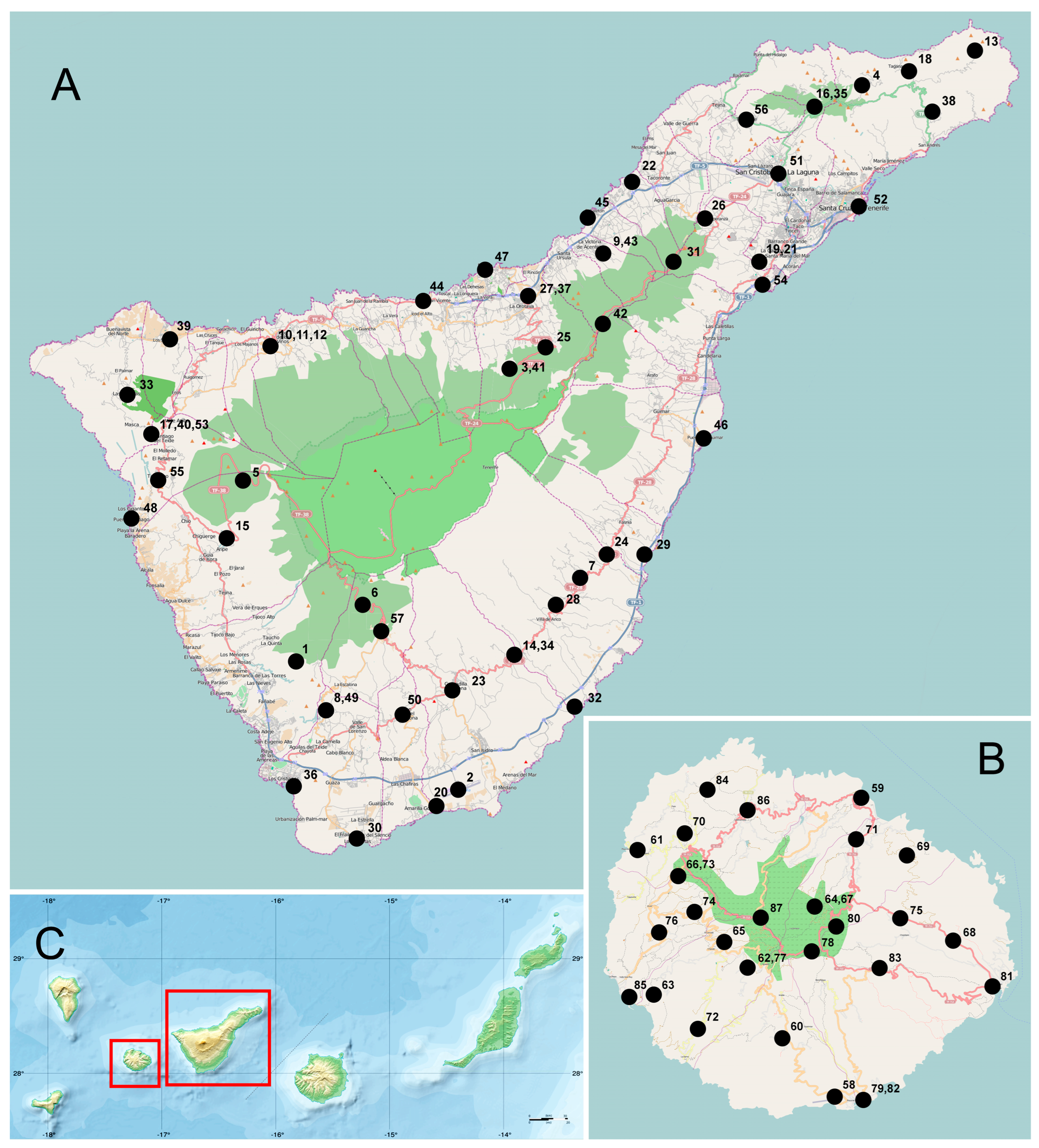
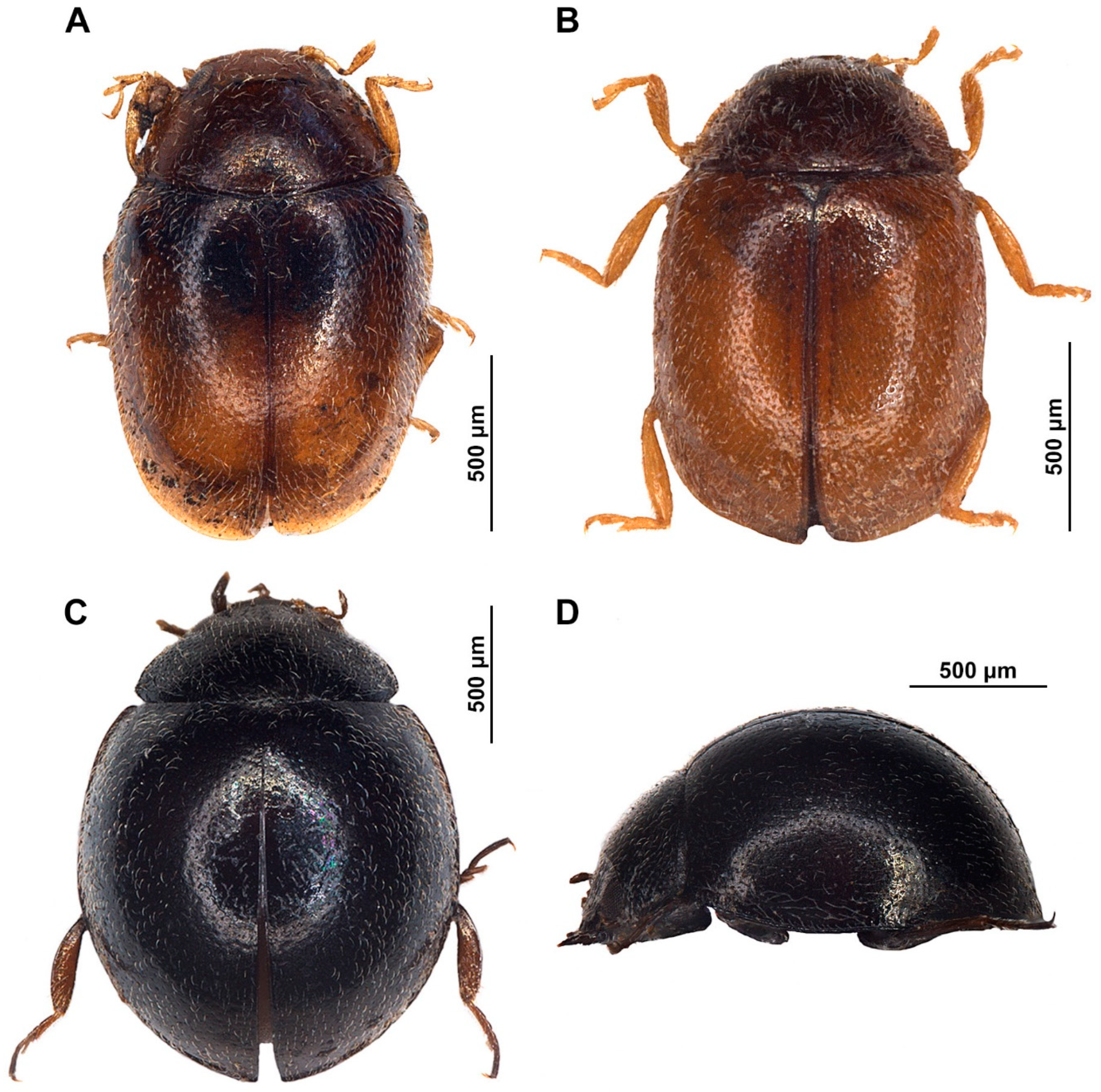
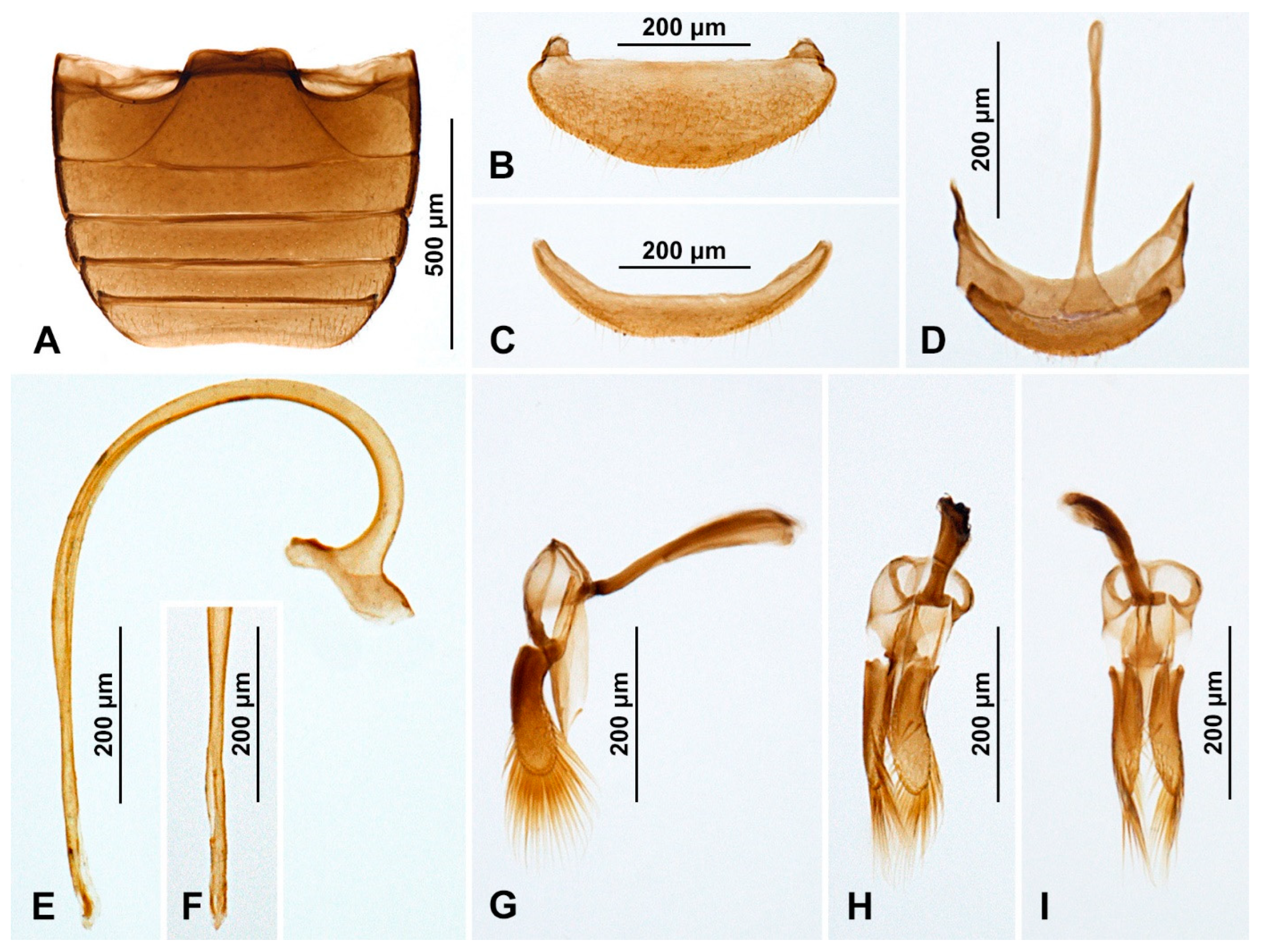
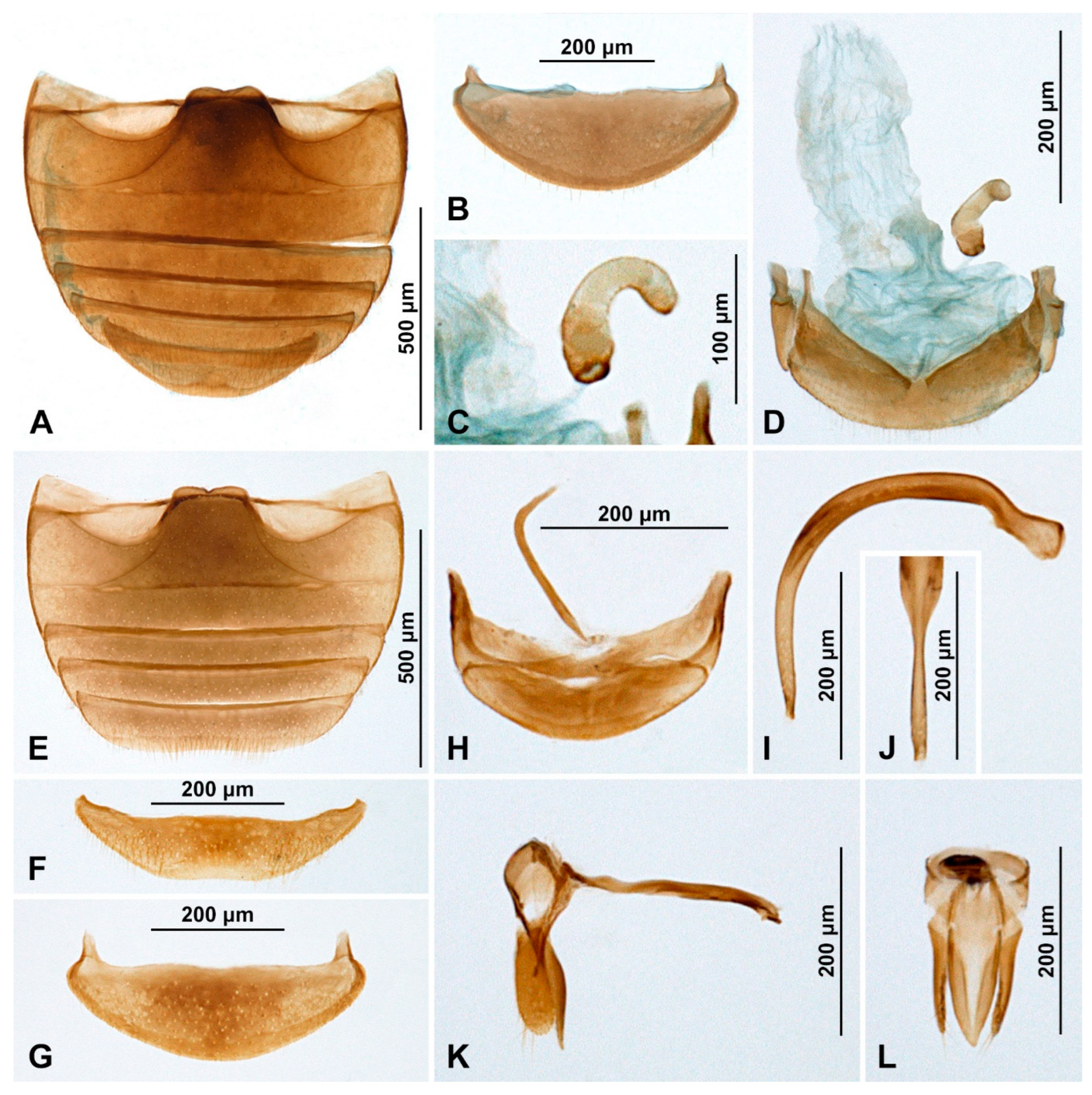
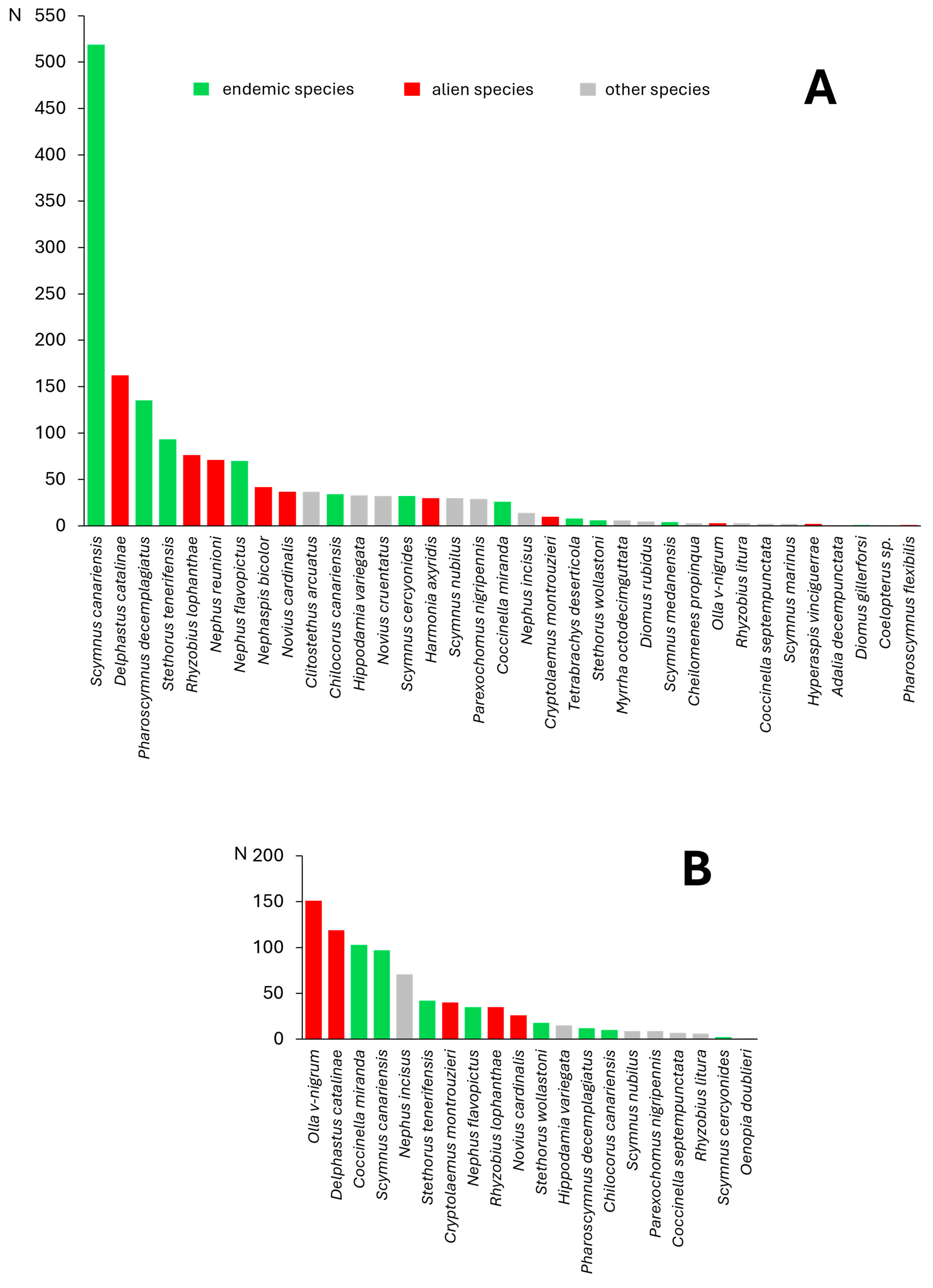
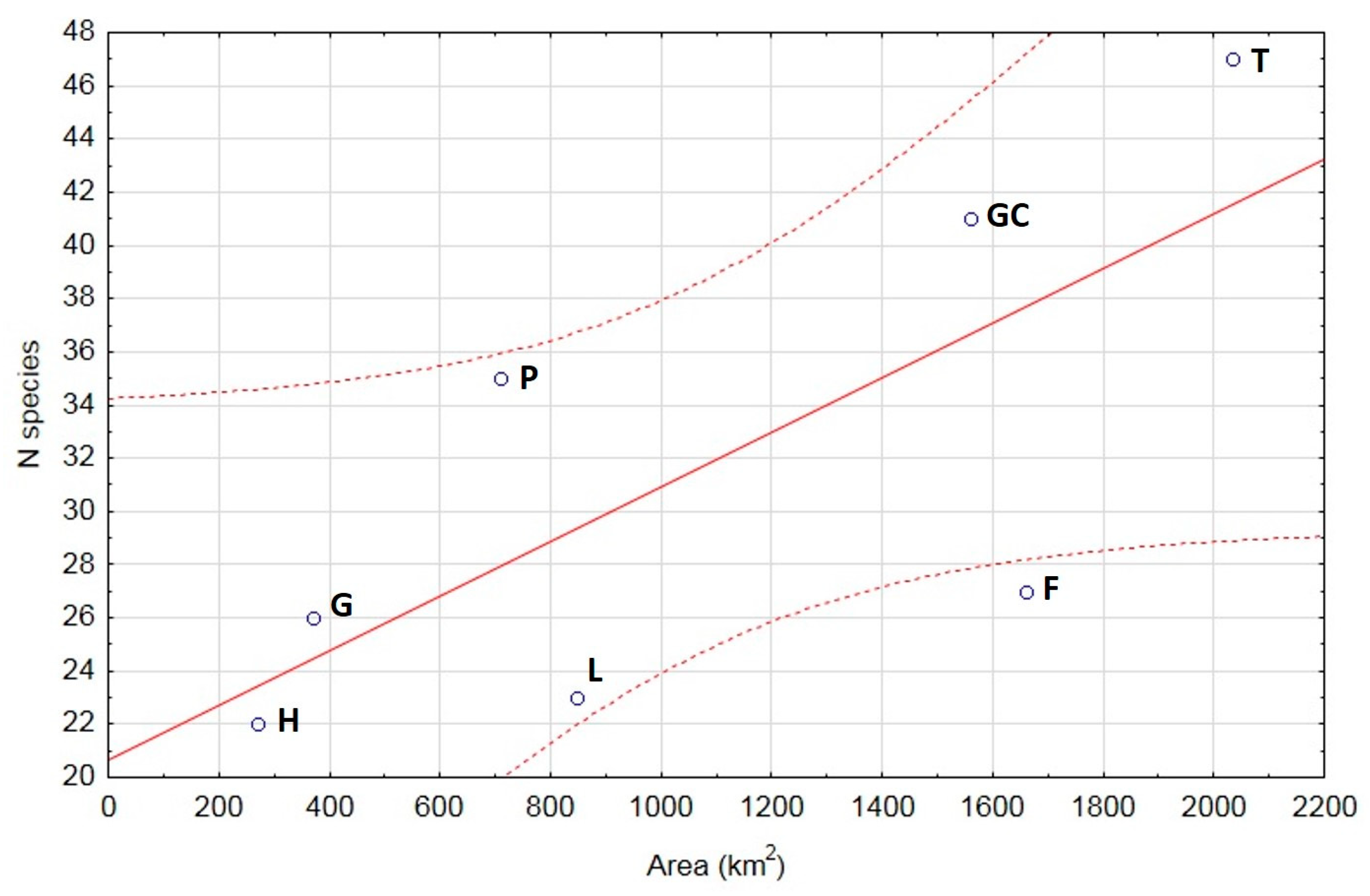
| Species | L | F | GC | T | G | P | H |
|---|---|---|---|---|---|---|---|
| Stethorus tenerifensis Fürsch | + | + | + | + | + | + | + |
| Stethorus wollastoni Kapur | + | + | + | + | + | + | + |
| Adalia testudinea (Wollaston) | + | + | |||||
| Coccinella miranda Wollaston | + | + | + | + | + | + | |
| Novius canariensis Korschefsky | + | + | + | + | |||
| Nephus depressiusculus (Wollaston) | + | + | + | ||||
| Nephus flavopictus (Wollaston) | + | + | + | + | + | + | + |
| Scymnus cercyonides Wollaston | + | + | + | + | + | ||
| Scymnus canariensis Wollaston | + | + | + | + | + | + | + |
| Scymnus medanensis Eizaguirre | + | + | + | + | |||
| Diomus gillerforsi Fürsch | + | + | |||||
| Chilocorus canariensis Crotch | + | + | + | + | + | + | |
| Parexochomus bellus (Wollaston) | + | ||||||
| Parexochomus quadriplagiatus (Wollaston) | + | + | + | ||||
| Pharoscymnus decemplagiatus (Wollaston) | + | + | + | + | + | + | + |
| Tetrabrachys deserticola (Wollaston) | + | + | + | ||||
| Number of species | 7 | 10 | 15 | 14 | 8 | 11 | 9 |
Disclaimer/Publisher’s Note: The statements, opinions and data contained in all publications are solely those of the individual author(s) and contributor(s) and not of MDPI and/or the editor(s). MDPI and/or the editor(s) disclaim responsibility for any injury to people or property resulting from any ideas, methods, instructions or products referred to in the content. |
© 2024 by the authors. Licensee MDPI, Basel, Switzerland. This article is an open access article distributed under the terms and conditions of the Creative Commons Attribution (CC BY) license (https://creativecommons.org/licenses/by/4.0/).
Share and Cite
Romanowski, J.; Ceryngier, P.; Vĕtrovec, J.; Zmuda, C.; Szawaryn, K. Diversity of Ladybird Beetles (Coleoptera: Coccinellidae) in Tenerife and La Gomera (Canary Islands): The Role of Size and Other Island Characteristics. Insects 2024, 15, 596. https://doi.org/10.3390/insects15080596
Romanowski J, Ceryngier P, Vĕtrovec J, Zmuda C, Szawaryn K. Diversity of Ladybird Beetles (Coleoptera: Coccinellidae) in Tenerife and La Gomera (Canary Islands): The Role of Size and Other Island Characteristics. Insects. 2024; 15(8):596. https://doi.org/10.3390/insects15080596
Chicago/Turabian StyleRomanowski, Jerzy, Piotr Ceryngier, Jaroslav Vĕtrovec, Christian Zmuda, and Karol Szawaryn. 2024. "Diversity of Ladybird Beetles (Coleoptera: Coccinellidae) in Tenerife and La Gomera (Canary Islands): The Role of Size and Other Island Characteristics" Insects 15, no. 8: 596. https://doi.org/10.3390/insects15080596
APA StyleRomanowski, J., Ceryngier, P., Vĕtrovec, J., Zmuda, C., & Szawaryn, K. (2024). Diversity of Ladybird Beetles (Coleoptera: Coccinellidae) in Tenerife and La Gomera (Canary Islands): The Role of Size and Other Island Characteristics. Insects, 15(8), 596. https://doi.org/10.3390/insects15080596







